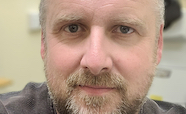
Rob Woolley
Confocal laser scanning microscopy enables the reconstruction of three-dimensional structures by capturing multiple two-dimensional images that have the out-of-focus blur removed.
We also have a number of research-grade light microscopes available for use.
Most also have epi-fluorescence as well as bright field capabilities. The µCT (micro-computed tomography) scanner uses Computerised Axial Tomography (CAT) to produce a series of digital slices of solid objects.
More about the confocal microscopy team
More about how confocal microscopy works
Your project
Project discussion with staff is essential prior to registration and training in the use of equipment.
Staff will help you design a practical experiment and train you to use the equipment. You are not expected to master every function of the instruments and can ask for help at any time, whether it be in using the equipment or the design of your experiment.
Initial advice and consultation
Contact the manager, Dr Rob Woolley, for initial advice and consultation:
Email confocal.microscopy@otago.ac.nz
For advice on the latest academic advances contact:
Dr Laura Gumy
Academic Leader, Confocal Microscopy
Email laura.gumy@otago.ac.nz
Services and techniques
- Access for downloading your confocal data
- Confocal microscopy equipment for trained independent users
- Confocal microscopy image analysis
- Research design advisory services and support
- Training for equipment use
Equipment
Arriving 2024 Zeiss LSM 900 Airyscan and Neoscan N80.
Below is a list of the major items of equipment available. We strongly encourage you to seek our advice in the early planning of your project.
Please contact Rob for advice on costs:
Email confocal.microscopy@otago.ac.nz
To use our equipment you will need to register your project and undergo training.
See our confocal microscopy equipment and specifications page or select the relevant links below for all the equipment listed here, with specifications.
Confocal microscopes
For most biological samples, fluorescent markers are required to use the confocal microscope.
Generally, if you've successfully stained your samples and viewed the results under an ordinary epi-fluorescence microscope, your samples will be suitable for the confocal.
How confocal microscopy works will advise you more about capabilities, optical sectioning, and using the Zeiss control panel.
- Nikon A1+ Inverted Confocal Laser Scanning Microscope
- Nikon A1R Multi-Photon Confocal Laser Scanning Microscope (restricted access)
- Andor Dragonfly Spinning Disk Confocal Laser Scanning Microscope on a Nikon Ti2-E inverted microscope
Light microscopy
We have a number of research-grade light microscopes available for use. Most also have epi-fluorescence as well as bright field capabilities. Bright field is where white light is shone through a thinly sliced specimen, fluorescence microscopy is where a high energy light source illuminates the sample on the same side it's viewed from (epi-illumination).
A general purpose light microscope is the work horse of our facility. It has good enough optics to obtain publication-quality images and is useful for checking labelling procedures before using a confocal microscope. Other, more specialised microscopes, can obtain montages of large specimens or help you with stereology investigations.
We have a Nikon Ti2-E inverted bright field and fluorescence microscope available for research use.
µCT X-ray scanning
The µCT uses Computerised Axial Tomography (CAT) to produce a series of digital slices of solid objects. Best suited to hard materials such as bone, teeth, wood, rocks and the like. Also useful for food items or samples with air spaces. The µCT can resolve details down to about 1µm.
Using X-rays the µCT works in the same way as a clinical CT scanner or CAT (computer aided tomography) scanner. Hundreds of X-rays are collected of the sample, each a fraction of a degree rotated from the previous one. By complex computing, a series of cross sections can be produced to reveal the inner structure of the object.
Project registration
Before you can be trained to use any of our equipment, or begin a new project, you must read and agree to our User Policy and complete a Project Registration form.
User Group
The User Group consists of members that represent University of Otago departments that use the Confocal Microscopy unit and it advises the OMNI Academic Advisory Group on direction and strategy.
Visit the About us page for information about how our user groups work and how to make contact.
Costs
Users can choose to be charged at the casual hourly rate or to prepay for a Tiered Fee.
Health Science Division (HSD) rates only apply to HSD Dunedin campus departments.
Tiered fee
Tier user application form (PDF)
OMNI Electron and Confocal Microscopy tiered charges 2025 (PDF)
Training and online resources
Technique training and support
Contact us for training:
Email confocal.microscopy@otago.ac.nz
Image analysis resources and support
Visit confocal microscopy image analysis for advice on programs' capabilities and links to online resources.